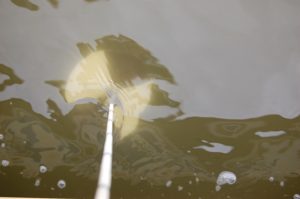October 20, 2021
Helping Test Out New Turbidity Technology
Arundel Rivers Federation has been excited to help Smithsonian Environmental Research Center (SERC) to test a new way to measure the clarity of the water in the Chesapeake Bay and the world. It is actually quite challenging and even expensive to get a very accurate measure of water clarity. As a result, most universities and environmental organizations use a secchi disk, a technology that is over 150 years old. The Federation and the Severn River Association has been taking out SERC interns out when we are out testing the water quality to help SERC verify the accuracy of a new method of measuring water tubidity. See below the write up from one of SERC’s interns, Ryan Kim.

Taking a Picture of Bay Water Quality
Hello! My name is Ryan Kim, a summer intern at the Smithsonian Environmental Research Center. This past summer, I’ve been a part of a project called the Chesapeake Water Watch. This is a NASA sponsored, Citizen Science Project where we are currently validating a smartphone application that is capable of measuring the turbidity and reflectance of the water. We are working with the local evironmental groups, Arundel Rivers Federation and Severn River Association, to test the app’s accuracy by going out on the Severn, South, West and Rhode Rivers.
What is the purpose of this project?
The purpose of this project is to engage Citizen Scientists to monitor water quality in the Chesapeake Bay by providing Citizen Scientists with data collection kits, including low-cost portable photometers, Secchi disks, materials to collect water samples, and training on using an open-source smartphone app called Hydrocolor.

As mentioned in the beginning, we are currently working on validating the Hydrocolor application, which is a free application on the Apple AppStore and the Google Play store that can easily be used by any Citizen Scientists or Volunteers when taking measurements of turbidity and the reflectance levels of the water. To accomplish this, Dr. Patrick Neale, along with Dr. Alison Cawood, Cosette Larash, Prof. Maria Tzortziou, and different interns have been working to validate the measurements from Hydrocolor by comparing the data from Hydrocolor to data that we collect from the lab, data we collect from a submersible probe, water samples, and satellite data that NASA collects with their high-resolution satellite sensors.
Why is this project important?
The goal is to make turbidity data measurements more accessible and affordable for volunteers and Citizen Scientists. Measuring turbidity is important because turbidity is a measurement of the cloudiness in a body of water, and if there is high turbidity, it would mean that there would be less sunlight going through the water to the underwater plants which produce oxygen for underwater organisms. High turbidity often arises from shoreline erosion or improper storm water management so these measurements flag areas of the bay where these need to be improved. And if we have a multitude of Volunteers and Citizen Scientists all collecting data, the large amounts of data will feed into ground-truthing of satellite measurements.
These results will help us understand if it is possible to monitor water quality using satellite data, which would be a great resource in assessing the health of the Chesapeake Bay, and other bodies of water around the world!